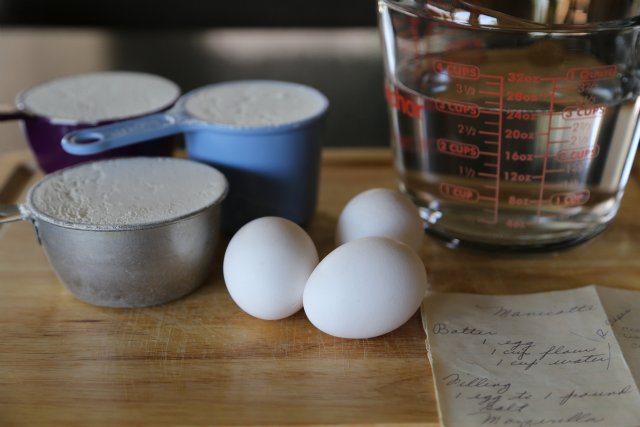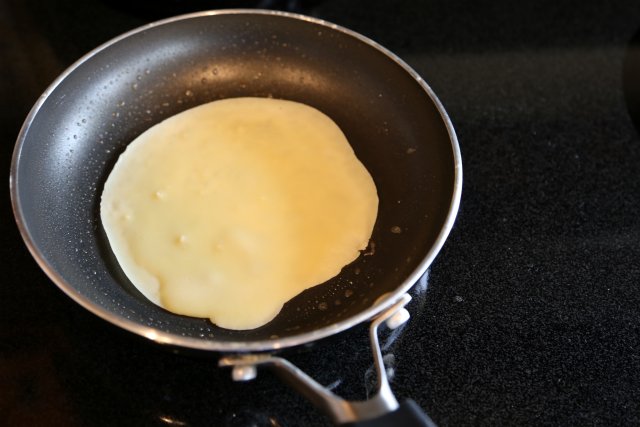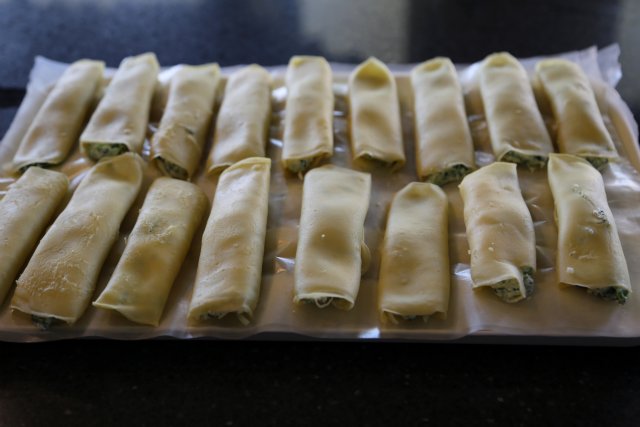The recipe has been handed down from generation to generation. I got it from Nona (you remember my mother-in-law, right?) who got it from her mother-in-law (my husband's grandmother whom I never had the pleasure of meeting) who got it from her mother. It may have gone back farther but Nona only knew for certain it went back to her grandma-in-law. So my grandchildren will be eating manicotti made from a recipe from their great-great-great-grandma. Wow!
Nona and I made manicotti together at least a half dozen times. It took that many times for me to get a written recipe with accurate measurements rather than "some of this" and "a little of that."
Nona wrote the recipe on a piece of paper one time we made them. Although I keep a typed copy on my computer, I always use the hand-written one when I make manicotti - it's like she's with me.
After years of practice I can get my "crepes" to be almost circular. But that was not always the case. At first some were long and skinny and others had a thin, finger-like projection coming out of them. Seriously, it's not as easy as it looks! But Nona never laughed, she just said, "Try again, you'll get it soon!"
I have many happy memories of us working and laughing together so it is only natural that I would think of her every time I make them. As I was making the "crepes" I remembered Nona, who was Jewish, telling me she learned to make blintzes - which are essentially crepes - from her mother. Hmmm. Before long I had made 38 "crepes" - about a third of what I will eventually need this summer.
Once the "crepes" had cooled, it was time to fill them. This process takes over my entire counter as I portion out the filling and then readjust if I run short or have extra left over. As I filled them, I was reminded of making enchiladas - a very similar concept and process. And, really, isn't a corn tortilla similar to a crepe or a blintz?
I could almost taste the gooey, stringy deliciousness these will become once they are cooked and covered with sauce!
The final step is rolling the "crepes" creating a tube-like pasta that is already filled. This step reminded me of Chinese Spring Rolls because the trick is to "make them snug but not so snug they tear!" Have you ever gotten a Spring Roll that split?
After they are rolled, they get stacked between sheets of waxed paper on a tray, wrapped with plastic wrap and then put in the freezer for a day or two. After they are completely frozen, I put them in a ziploc bag and pop them back in the freezer. I can then pull out as many or as few as I need at a time.
As I was cleaning up (you can imagine the mess on my counter!) I began thinking about ethnicities and food. It seems ethnicities and cultures, although very different in many ways, have commonality in some of their foods. A Jewish blintz, French crepe, Italian manicotti, Mexican enchilada and Chinese spring roll are all basically a flat starchy substance rolled with a filling in the center and served with a sauce of some sort. The flavors are very different, but the concept is the same.
You say potato, I say patahto.





No comments:
Post a Comment